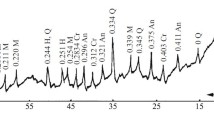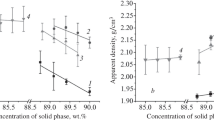Abstract
The results of research on compositions based on sodium liquid glass and fillers of mineral and organic origin are presented. Materials that can affect the molding properties and thermal transformations of compositions are used as fillers. It was found that the molding properties of the compositions depend on the mineral composition and content of the filler. It is shown that the greatest increase in the viscosity of the compositions is provided by fine mineral fillers, which limit the influence of free and adsorptive water in the composition of liquid glass. The influence of the dispersion of fillers on the rheological properties of compositions is determined. It was found that an increase in the specific surface area of fillers from 350 to 550 m2/kg can increase the structural strength of molding mixtures by 10–30%. To improve the molding properties of compositions characterized by high porosity, it is proposed to use combined fillers: glass boilerplate and organic filler; broken glass and mineral filler containing a pore-forming component (oil shale, gaize, lignite-bauxite, and refuse ore). The expediency of using fillers with a porous structure is shown. Studies of porous compositions have confirmed the advantages of using combined fillers. It is noted that the use of combined fillers contributes to the porization of liquid-glass compositions at low temperatures.
Access provided by Autonomous University of Puebla. Download conference paper PDF
Similar content being viewed by others
Keywords
1 Introduction
The development of efficient light concrete technology depends on the quality of porous aggregates. Relevant research is aimed at reducing the density and increasing the strength of aggregates, reducing the energy intensity of production [1,2,3,4,5,6,7,8,9,10]. On the basis of liquid glass, cellular concretes and granulated materials of various sizes and purposes are obtained. The porization of liquid-glass compositions is carried out mainly by swelling [4, 7, 10]. For the development of effective heat-insulating liquid-glass materials, the choice of fillers is important, aimed at optimizing the technological state of the compositions.
The aim of this work is to study the influence of fillers on the molding properties of compositions based on liquid glass.
2 Materials and Methods
Sodium liquid glass with a density of 1400 kg/m3 was used to produce the compositions. The compositions realize the multifunctionality of liquid glass: binding of the filler during the formation of the raw material, reducing the temperature of the pyroplastic state of the mass, and pore formation.
Fillers of various origins were inserted into the compositions. The broken glass – ground container and sheet silicate glass. Gaize is an overburden siliceous microporous rock, consisting mainly of amorphous silica. Oil shale is a rock that is simultaneously extracted during the development of coal deposits and contains kaolinite, hydromica, feldspar, calcite, and quartz. Lignite-bauxite is an alumina rock for the production of aluminum, represented by aluminum hydroxides and enriched with fine carbonized wood residues. Skarn-black iron ore processing wastes are formed during magnetic separation of the rock mass and include calcium silicates, aluminosilicates, pyrite, and calcite. Sawdust and wheat husks were added to the composition as fillers of plant origin. Porous fillers of compositions: ash microsphere – loose waste from fuel combustion, consisting of hollow spherical particles with a diameter of 100–350 microns; crushed gas silicate with a particle size of 0.5–1.25 mm, obtained by grinding process waste from cellular concrete production.
Mineral fillers were crushed in a high-speed Emax mill. The specific surface of the powders was measured using a FSH–6K photosedimentometer. Liquid-glass compositions were prepared by thoroughly mixing the components. The structural strength of the compositions was determined on a conical plastometer. Taking into account the structural strength indicators, a method for manufacturing samples was assigned. The dried samples were fired in a laboratory oven at a set temperature with an exposure time of 15 min. Structural transformations of materials were evaluated by density and swelling coefficient (the ratio of sample diameters before and after roasting).
3 Results and Discussion
The influence of fillers on the molding properties of liquid-glass compositions was studied, which were compared by changes in structural strength (Fig. 1). The state of the composition with 70% glass content and structure strength of 0.2 MPa (100%) was taken as the standard.
With a content of 65–75% of the filler, liquid-glass compositions acquire the required molding properties. The state of the raw material mass depends on the dispersion of the filler (Table 1). An increase in the specific surface area by 100–200 m2/kg is comparable to an increase in the filler content by 5–12%. With the same content of fillers having equal dispersion, the influence of the mineral composition of the solid component is obvious. The greatest increase in the viscosity of the compositions is provided by gaize rock, oil shale and lignite-bauxite, which reduce the influence of adsorption water in liquid glass.
At a roasting temperature of 650 °C in the presence of 35–45% of fillers, the structure of the swelling samples is stable (Fig. 2). Different intensity of the swelling of such compositions is due to the chemical and mineral characteristics of the fillers. The highest coefficient of swelling is provided by fillers that exhibit thermal activity with the release of a gas phase (refuse ore, gaize) or a gel-forming effect (broken glass).
Samples containing 0 and 35% of the filler, roasted at a temperature of 850 °C, fused with shrinkage. For compositions with filler content of 45% or higher, the influence of the type and amount of filler increases (Fig. 2). Structural changes in samples with high filler content, burned at 850 °C, are due to the properties of the solid part of the compositions. At elevated temperatures, the reactivity increases, and the composition of the fired composition changes.
Liquid-glass compositions with a limited content of filler are characterized by the greatest pore forming ability. However, the molding properties of such masses are unsatisfactory (Fig. 1). To increase the viscosity of compositions with a high content of liquid glass, salt modifiers are used [3], which sharply reduce the plasticity of the composition.
To regulate the molding properties of the raw material mass, the effect of additives of plant origin was studied (Table 2). Organic fillers with a particle size of 0.1–0.3 mm were added to liquid-glass compositions based on broken glass. This contributed to a decrease in the plasticity of the raw material mass. The rational content of the vegetable additive of 5–7% allows maintaining high porosity of the composition.
The possibility of improving the properties of molding masses while maintaining the pore forming ability of liquid-glass compositions due to combined fillers is investigated. The expediency of combining broken glass that provides a high degree of swelling with materials that increase the viscosity of molding mixtures and contribute to additional porization of the composition, for example, oil shale is shown (Table 3).
Compositions containing 45–55% of the combined filler have improved molding properties and are characterized by increased porosity. The structure of materials is characterized by thin-walled cells, the smallest cavities in the partitions between the pores (Fig. 3).
Studies of compositions containing porous fillers revealed the possibility of regulating the molding properties and swelling by changing the ratio of “ash microsphere: crushed gas silicate”. Compositions containing 45–50% of a porous filler with a predominance of ash microspheres are preferred (Fig. 4).
The combination of fillers ensures the implementation of various porization methods in the area of low temperatures, and helps to increase the thermal protection properties of compositions based on liquid glass.
4 Conclusion
The type of filler determines the state of the molding mass and the intensity of the processes of thermal porization of liquid-glass compositions. The expediency of using combined fillers made up of materials that directly affect the technological properties of compositions is shown. Compositions containing mineral, organic and porous fillers that provide the required molding properties of the raw material mass and increase the porosity of the roasted material are proposed.
References
Wang, W.C., Chen, B.T., Wang, H.Y., Chou, H.C.: A study of the engineering properties of alkali-activated waste glass material (AAWGM). Constr. Build. Mater. 1(112), 962–969 (2016)
Rafael, A.R., Rivera, J.F., Gutiérrez, R.M.: Alkali-activated building materials made with recycled construction and demolition wastes. Constr. Build. Mater. 15(149), 130–138 (2017)
Mizuriaev, S.A., Zhigulina, A., Solopova, G.S.: Production technology of waterproof porous aggregates based on alkali silicate and non-bloating clay for concrete of general usage. Procedia Eng. 111, 540–544 (2015)
Redden, R., Neithalath, N.: Microstructure, strength, and moisture stability of alkali activated glass powder-based binders. Cement Concr. Compos. 1(45), 46–56 (2014)
Radayev, S., Seleznyova, O., Ilyukhin, K., Ivanov, K., Forosevich, N.: The problem of structurization of liquid glass. Mater. Sci. Forum 871, 90–95 (2016)
Yang, K.H., Lee, K.H., Song, J.K., Gong, M.H.: Properties and sustainability of alkali-activated slag foamed concrete. J. Clean. Prod. 1(68), 226–233 (2014)
Miruk, O.: Development of cellular structure composites for energy efficient construction. Energy Procedia 9(128), 469–476 (2017)
Kim, G.B., Jang, I.Y., Kim, S.K., Lee, K.W.: A properties of concrete using LCD waste glass subjected to sulfate attack. Key Eng. Mater. 7(773), 233–237 (2018)
Jiang, X.J., Yun, Y., Hu, Z.H.: Development of non-autoclaved aerated concrete by alkali activated phosphorus slag. Adv. Mater. Res. 5(250–253), 1147–1152 (2011)
Rakhimova, N.R., Rakhimov, R.Z.: Alkali-activated cements and mortars based on blast furnace slag and red clay brick waste. Mater. Des. 15(85), 324–331 (2015)
Acknowledgements
This research is funded by the Science Committee of the Ministry of Education and Science of the Republic of Kazakhstan (Grant No. AP08856219).
Author information
Authors and Affiliations
Corresponding author
Editor information
Editors and Affiliations
Rights and permissions
Copyright information
© 2021 The Author(s), under exclusive license to Springer Nature Switzerland AG
About this paper
Cite this paper
Miryuk, O.A. (2021). Molding Properties of Alkali Silicate Compositions. In: Klyuev, S.V., Klyuev, A.V. (eds) Proceedings of the International Conference Industrial and Civil Construction 2021. ICICC 2021. Lecture Notes in Civil Engineering, vol 147. Springer, Cham. https://doi.org/10.1007/978-3-030-68984-1_18
Download citation
DOI: https://doi.org/10.1007/978-3-030-68984-1_18
Published:
Publisher Name: Springer, Cham
Print ISBN: 978-3-030-68983-4
Online ISBN: 978-3-030-68984-1
eBook Packages: EngineeringEngineering (R0)








